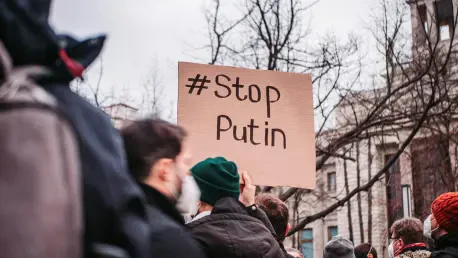Imagine a financial battlefield where billions of dollars stand frozen, poised to become a lifeline for a war-torn nation, as nearly $350 billion in Russian sovereign assets have been immobilized by Western nations in a strategic maneuver to pressure President Vladimir Putin during the ongoing conflict with Ukraine. This staggering sum represents not just money, but a potential turning point in geopolitical strategy and humanitarian aid. This roundup gathers diverse opinions, insights, and analyses from various global perspectives to explore whether these assets could be redirected to support Ukraine’s recovery and force a resolution to the conflict. The purpose is to dissect the legal, strategic, and ethical dimensions of this unprecedented financial tactic, offering a comprehensive view of its implications.
Western Resolve: Voices on Redirecting Russian Funds
A Unified Stance Among Allies
Across Western capitals, there is a growing consensus on using frozen Russian assets to bolster Ukraine. Leaders from nations like the United Kingdom, France, and Germany have publicly endorsed this approach, emphasizing a collective strategy to repurpose these funds. Reports indicate that the European Union holds approximately $245 billion, while the UK has frozen about $36 billion, showcasing the scale of this financial leverage. Many policymakers argue that such measures are essential to sustain Ukraine’s defense capabilities amid relentless attacks on its infrastructure.
Diverging Views on Scope of Action
However, opinions differ on how far this strategy should go. Some government officials advocate for using only the profits and interest generated by these assets, citing concerns over legal repercussions of seizing the principal amounts. Others push for outright confiscation, believing that a bolder move could significantly alter Russia’s stance in peace negotiations. This debate highlights a tension between maintaining international norms and the urgent need to support a nation under siege, with various stakeholders weighing the risks and rewards of each path.
Impact on Peace Talks
Analysts from think tanks and international forums also chime in on whether financial pressure can truly influence Putin’s decisions. A segment of strategic experts suggests that the loss of such a massive sum might compel Russia to engage in meaningful dialogue, especially as domestic economic pressures mount. Yet, skepticism persists among some observers who argue that financial tactics alone may not sway a leader whose priorities appear rooted in territorial and political ambitions over economic stability.
Legal Challenges: Opinions on Sovereign Asset Seizure
Navigating International Law
The legal landscape surrounding the potential seizure of Russian assets is fraught with complexity, and perspectives on this issue vary widely. Legal scholars and international bodies generally agree that while freezing assets is within the bounds of current frameworks, outright confiscation poses significant hurdles since Russia retains ownership under international law. This creates a dilemma for nations seeking to fund Ukraine’s recovery without setting controversial precedents.
Evolving Legal Arguments
Recent discussions, including high-level meetings among European leaders, have spurred new arguments for reparations. A notable proposal involves a $162 billion loan to Ukraine backed by these frozen funds, reflecting a shift toward innovative legal interpretations. Some legal experts caution against the long-term implications of such actions on global financial systems, while others assert that the moral imperative to hold Russia accountable justifies pushing these boundaries.
Balancing Precedent and Necessity
The discourse also touches on the balance between adhering to established norms and addressing immediate crises. Certain policy advisors highlight the risk of undermining trust in international financial institutions if assets are seized without clear legal grounding. Conversely, advocates for Ukraine stress that the scale of destruction warrants exceptional measures, suggesting that a carefully crafted framework could mitigate broader fallout while delivering justice.
Humanitarian Perspectives: Funding War Victims
Calls for Reparations
Beyond state-level strategies, civil society organizations bring a poignant humanitarian angle to the conversation. Many groups advocate for allocating a portion of the frozen assets—potentially around 2% of a proposed loan, equating to $2.8 billion—to support victims of war atrocities such as torture and sexual violence. This viewpoint emphasizes that financial strategies must extend beyond military aid to directly address the human toll of conflict.
Innovative Justice Models
Voices from non-governmental sectors argue that redirecting funds to survivors represents a progressive step in conflict resolution. They point to the need for justice mechanisms that prioritize rebuilding lives, drawing parallels with efforts in other war zones to integrate reparations into recovery plans. This approach challenges traditional focuses on governmental support, urging a dual emphasis on both national defense and individual healing.
Broader Implications for Conflict Zones
Humanitarian advocates also note that such a model could set a benchmark for future conflicts, reshaping how reparative justice is approached globally. Some suggest that integrating victim support into financial warfare tactics offers a holistic response to modern warfare’s complexities. This perspective garners mixed reactions, with some praising its forward-thinking nature and others questioning the feasibility of implementation amid political and logistical constraints.
Strategic Angles: Can Financial Pressure Shift Russia’s Position?
Tactical Intent Behind Asset Freezes
On the geopolitical stage, the strategic use of frozen assets as leverage against Russia draws varied analyses. Many military and political strategists view this as a critical tool to push Putin toward negotiations, especially given the sustained aggression against Ukrainian civilian targets. They argue that the sheer magnitude of $350 billion could create internal economic strain significant enough to alter Russia’s war calculus.
Historical Comparisons and Outcomes
Comparisons to past instances of financial coercion in international disputes are frequent among commentators. Some draw parallels to economic sanctions that have historically influenced state behavior, suggesting a potential for success if pressure is sustained. However, others caution that Russia’s resilience and alternative economic partnerships may dilute the impact, rendering the tactic less effective than anticipated.
Redefining Global Norms
A forward-looking segment of thought leaders explores how this financial maneuver might reshape global conflict dynamics. They posit that using sovereign wealth as a direct weapon in warfare could establish new norms for economic leverage, potentially affecting how nations approach disputes. This speculation is met with both optimism for innovative peacebuilding and concern over escalating economic warfare in future crises.
Key Takeaways: What This Debate Reveals
Synthesizing these diverse opinions reveals a multifaceted issue at the heart of the Russia-Ukraine conflict. Western unity stands as a powerful force, with legal challenges presenting significant but not insurmountable barriers. The humanitarian push for victim reparations adds a vital ethical layer, while geopolitical strategies underscore the potential of financial pressure to influence outcomes. These insights collectively paint a picture of a pivotal moment where economic tools intersect with justice and warfare.
Reflecting on a Historic Financial Strategy
Looking back, the discussions surrounding the $350 billion in frozen Russian assets marked a defining chapter in the intersection of finance and conflict resolution. The varied perspectives—from Western policymakers to legal experts and humanitarian advocates—underscored the complexity of balancing strategy with morality. Moving forward, stakeholders could consider structured frameworks to ensure asset repurposing aligns with both legal standards and victim needs. Exploring international coalitions for reparative justice models might offer sustainable solutions, while continued dialogue on global norms could prevent unintended escalations in economic warfare tactics. These steps provide a path toward not only addressing the immediate crisis in Ukraine but also shaping a more equitable approach to future conflicts.









